Nicole Graycar Report
Habitat for Humanity Global Village Program, Lesotho
Lesotho: August 2008
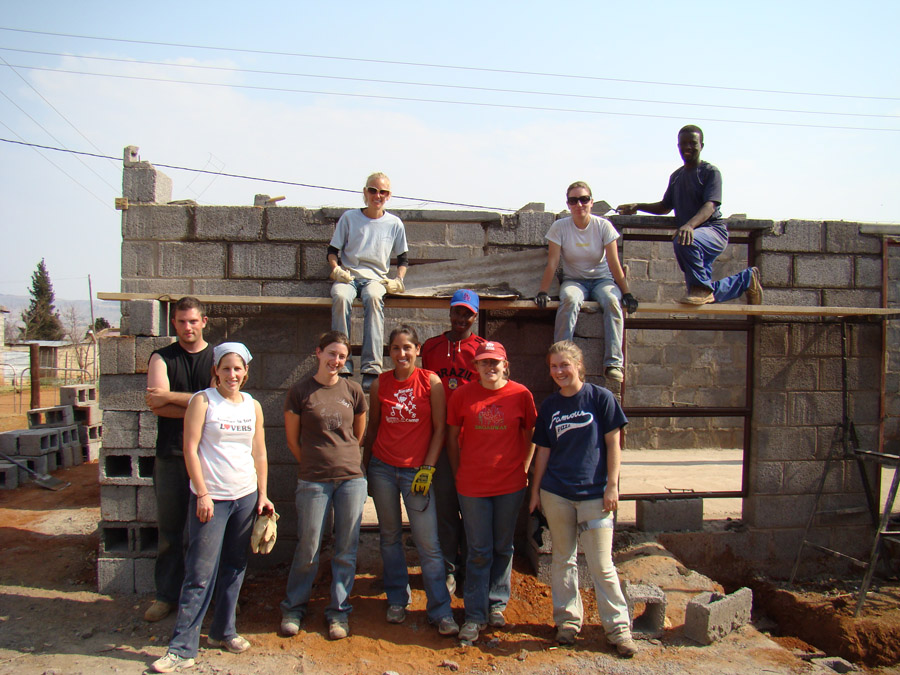 |
|
The team, Habitat for Humanity Global Village Program, Lesotho |
As I entered the security checkpoint at Pittsburgh International Airport leaving to fulfill my travel fellowship, I got quite emotional. This trip was included on my list of things to do before I died and it was happening so much earlier than I had expected. On the plane, I happened to be seated next to a six-year-old girl who was flying to Senegal to visit her grandmother. She asked me, “Are you going to Africa?” When I responded that I was, she immediately said “I didn’t know white people went to Africa”. Hundreds of questions followed in the realm of “Why do you have so much hair on your arms?” to “Am I your first brown friend?” As we approached cruising altitude she leaned across my lap and said that a cloud formation outside of the window was “God’s house”. The sun was setting just behind it, illuminating something that in all honesty did indeed look like a house befitting God. In a way she was preparing me so eloquently to see things that I had never seen before.
After the eighteen-hour flight, I was dying to see Cape Town. The drive into the city center is remarkable in many ways. Almost as soon as you leave the airport’s grounds, squatter settlements are right alongside the
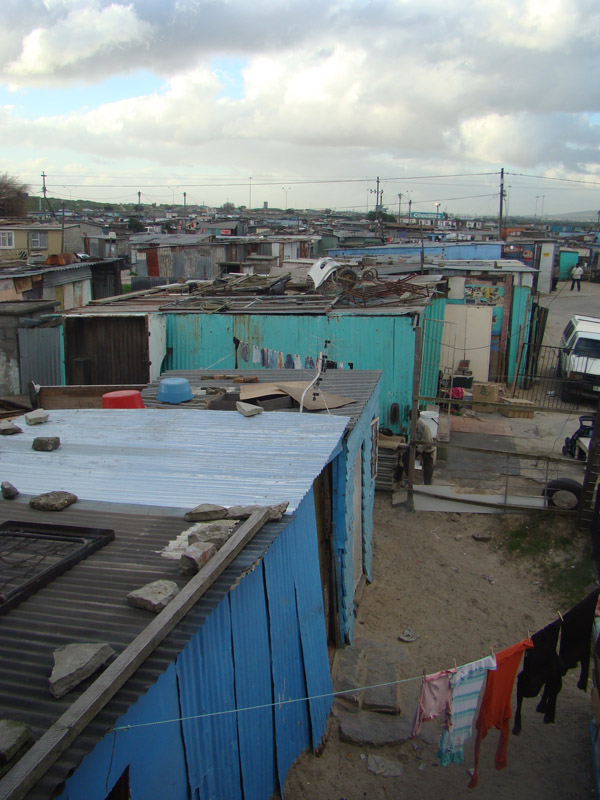 |
|
Cape Town Township |
highway. I thought that they would be hidden in a city like Cape Town, but one is made painfully aware of their presence. There is a tragic irony to have the dilapidated architecture of the townships set against a scene of the visually impressive harbor and Table Mountain.
My first day in Cape Town was spent exploring, and making the trip to Robben Island. On the ferry crossing, one can see Cape Town’s magnificent silhouette. Robben Island was the home to Nelson Mandela for many years, and numerous other criminal and political prisoners during its time as a maximum-security institution. Not only did I get to tour the facility, but also I got to tour the facility with one of Mandela’s friends mentioned on numerous occasions in A Long Walk to Freedom, Eddie Daniels.
The next day I visited five of Cape Town’s townships. We started at the District Six Museum, a facility dedicated to remembering the forced removal of an entire black community to make way for a white development that never came to fruition. A quote on the wall really resonated with me. A person who lived in the area before its reallocation was quoted saying that “it struck me that our history is contained in the homes we live in, that we are shaped by the ability of these simple structures to resist being defiled”. After writing my BERKELEY PRIZE essay about the defilement of homes by Hurricane Katrina, it supported my thoughts that our homes are the keepers of a personal dignity.
In the first township, Langa, I visited a local initiative to teach residents numerous crafting skills; the crafts are then sold on the premises. In a neighboring township we visited a rather famous establishment called “Vicki’s B&B” that is a hotel surrounded by shacks that gives a socially conscious traveler the opportunity to experience the townships on a deeper level.
No matter where we traveled, the conditions were the same. The majority of dwellings were made of metal scraps that were of a very small size without plumbing or legal electricity. Many families shared one latrine and locals fit barbershops and food stalls wherever they could. I couldn’t help but be overwhelmed with the sheer number of people living in such
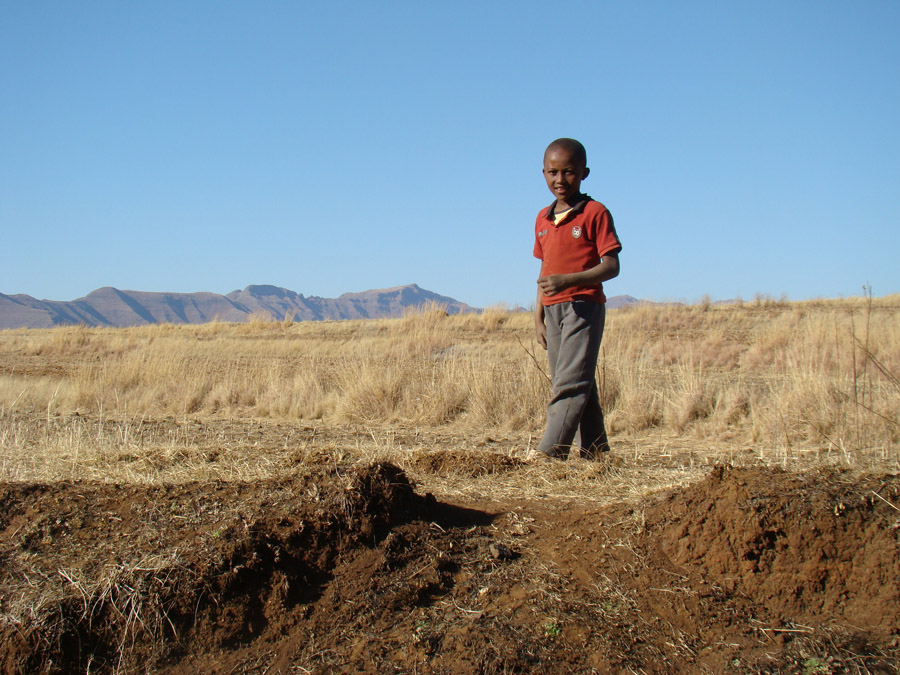 |
|
Boy walking near Meseru |
conditions.
Driving back towards the city center, there was an amazing sunset, and we stopped to take pictures. There was a young boy walking along a stream of waste who waved enthusiastically. I yelled to him if I could take his picture and he smiled so big. I needed that after the day that I had had. I had to remember that no matter how different those communities were, than what I knew, the human condition is universal.
The following morning I joined my fellow volunteers and headed to Lesotho. As we were approaching Maseru’s airport, all I could see were mountains and expansive blank spaces. It was the perfect cinematic moment as we exited onto the runway into one of the most gorgeous natural environments I have ever seen only to enter an international airport with no people in it, other than our plane’s passengers.
Our lodging was about two and one half hours drive from Maseru, in a small town called Pitseng. We watched the sunset as we moved along. The spaces gradually changed from dense urban fabric to the occasional cluster of residences. Smaller homes had thatched roofs. Many had rain barrels and occasionally the odd solar battery. All had pit latrines, which I can attest to being totally doable even if it was a little unpleasant. After finally getting to our
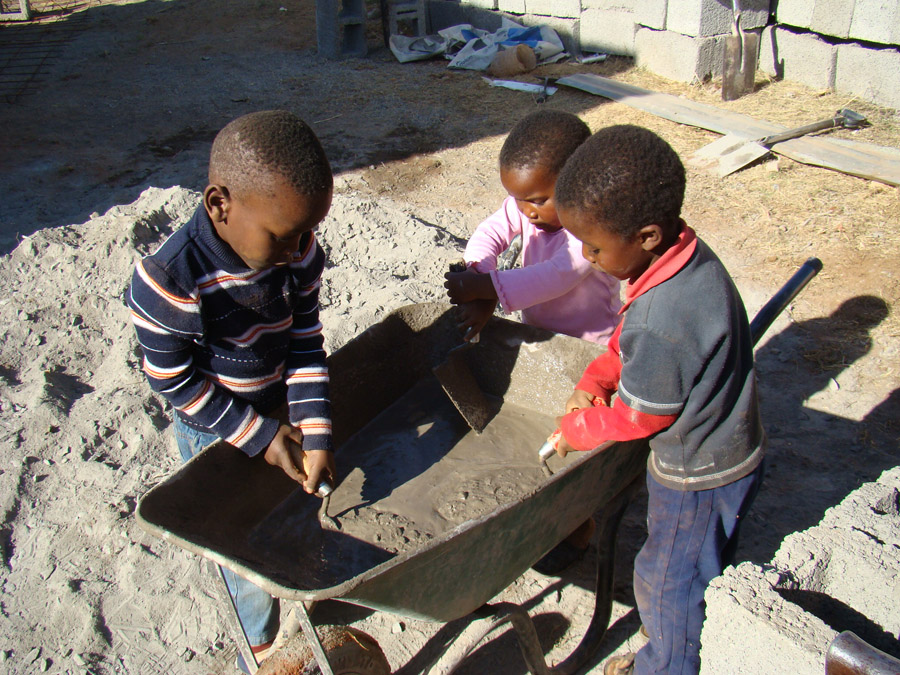 |
|
Kids mixing dagga |
guesthouse in Pitseng, we had our first experience of local fare: rice, chicken, and a version of grits called pap. We were pleasantly surprised to find running water that was occasionally warm. I was hoping to really ‘rough it’ but the simple comforts were much appreciated.
Our first journey into the local town was a Sunday afternoon stroll. We definitely caused a bit of a stir, but were always met with friendliness. We ran into many locals using donkey carts to get goods from place to place. Between dodging them and the runaway sheep, we passed a boy of no more than five who was herding two donkeys with his dog. He was very young, but knew how to keep his animals with him. I was surprised by the communal nature of the land. There aren’t any fences. Livestock can come and go with seemingly full access to all parts of the hillside. Traditional rondavels are still around,
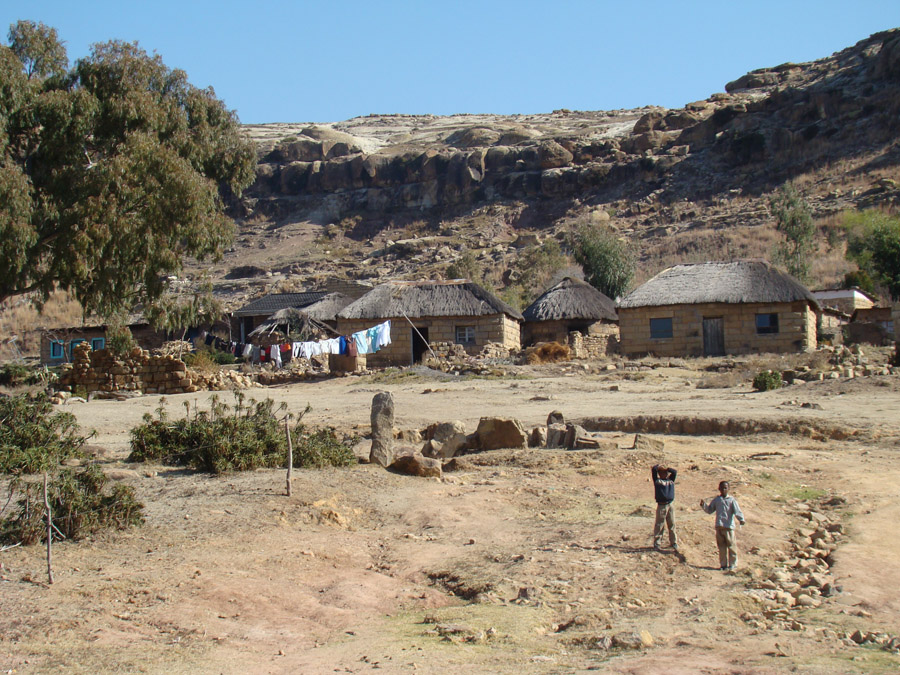 |
|
Thatched roof houses |
though the current trend is simple CMU blockhouses.
Our worksite was almost forty-five minutes away from the lodge, but I can’t imagine a more picturesque commute. The first workday we got to the site and the exterior walls were started, but the floor had not been poured. The contractor was a man in his 40’s lovingly referred to as ‘Papa’, because of his presence and command of such a large group of us girls. Almost immediately, local children started to gather, to point and to stare. It didn’t take much time for them to warm up to us, or even for them to help us mix the ‘dagga’ or concrete.
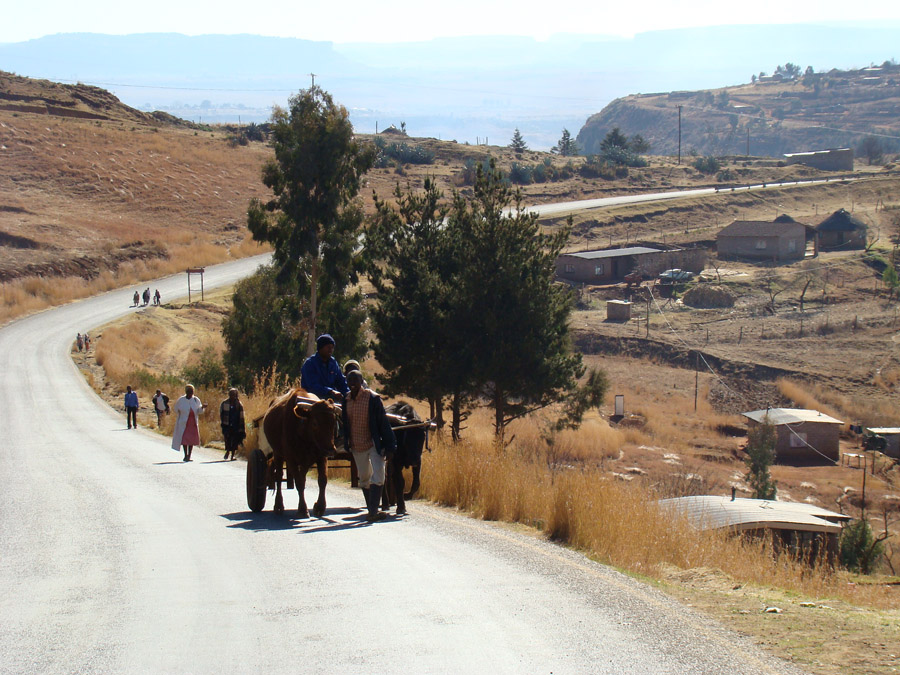 |
|
Donkey cart near worksite |
We mixed and poured the foundation, built-up the exterior walls, and created the interior partitions. The work was harder than I had imagined, but everyday when we left the site, we all had an immense feeling of accomplishment and knew that we had, indeed, sung for our supper.
One day during the first week of our own build, the work was put on hold as we were assigned to help build a pit latrine in a local village. We visited an almost completed orphan’s home which was constructed by a German team. There was a very different atmosphere at that site. Our main site was in a dense town on the border with South Africa. This site was literally in the middle of nowhere, so our presence was very intruding to most. We had to walk quite far to what can be described as a giant puddle with stagnant water, to fetch water for construction. Well water was too precious to use for concrete, so we lugged many, many barrels of water back to the site. Right next to the rainwater retention pond was the town’s primary school. When they saw us, all fifty of them sprinted down the hill to have a closer look and waved so enthusiastically. That wasn’t our only ‘rock star’ moment of the day.
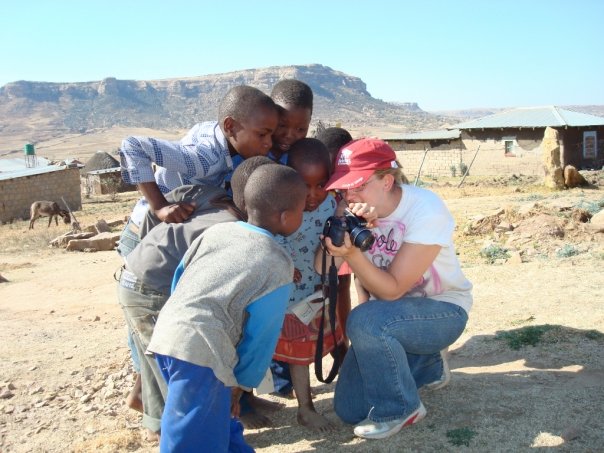 |
|
Kids and digital camera |
Back at the site, all the older kids congregated after school let out. We were all surrounded as we gave out crayons and coloring sheets. The most sought after object was my digital camera. They pushed and they shoved to get to me and giggled when I could take their picture and show it to them instantaneously on the screen. One girl, probably around thirteen, then made another exciting discovery. Some of my hair had fallen out from under my hat – and it was blonde. Immediately, she pulled off my hat and twenty girls each took hold of different locks while all were repeating, “blonde! blonde!” At the end of the day, one community member invited us to the crest of a hill and we watched a whole troupe of people performing a traditional Basotho dance. Women did extraordinary things with their shoulders and torsos to the beat of several musicians and a whistle. We should have known that we weren’t going to get away without trying to do it ourselves. I was the first of the women’s prey and got positioned in the leader’s spot. Not to state the obvious, but we were all white girls---a little out of our element. At the end of the dance, the leader of the drummers came up to me, shook my hand and gave an enthusiastic two-thumbs up. I was quite content to represent our group.
After building for six days, our ‘R&R’ day was spent at Tsenlanyane National Park. I am not normally a hiker; but our walk over the mountains was spectacular. The land was
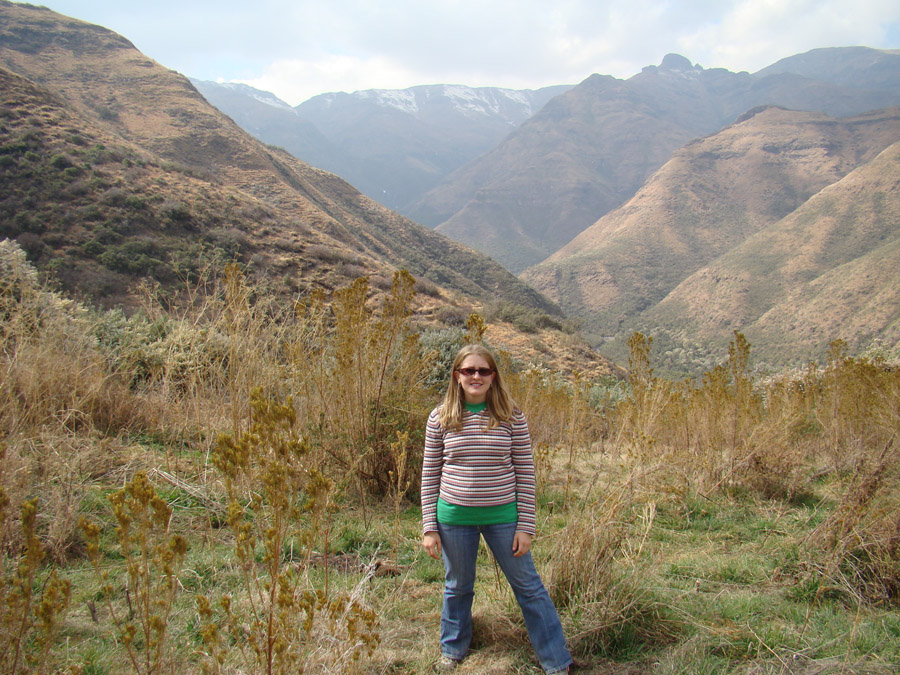 |
|
Tsenlanyane National Park |
untouched and pristine. On our way home, we drove through a village and once again, kids and adults alike surrounded our van. I had to smile when one of the teens in the group squealed to her friend that she had “touched them”. During that drive, we passed some kids who were sliding down the hill on pieces of cardboard boxes and some others who dropped everything and ran along the side of our van as we drove through the area. It seemed like a simple way to live.
Back at work, as we got to know the kids who lived around our site, we shared with them some of our favorite things as American kids. I got to help a little boy color for the first time, and cheer for a group of others as they experienced the joys of “Duck, Duck, Goose.” One afternoon, we visited the local primary school. The children put on an impromptu performance, including the recitation of bible verses, songs, comedy skits, and stomping.
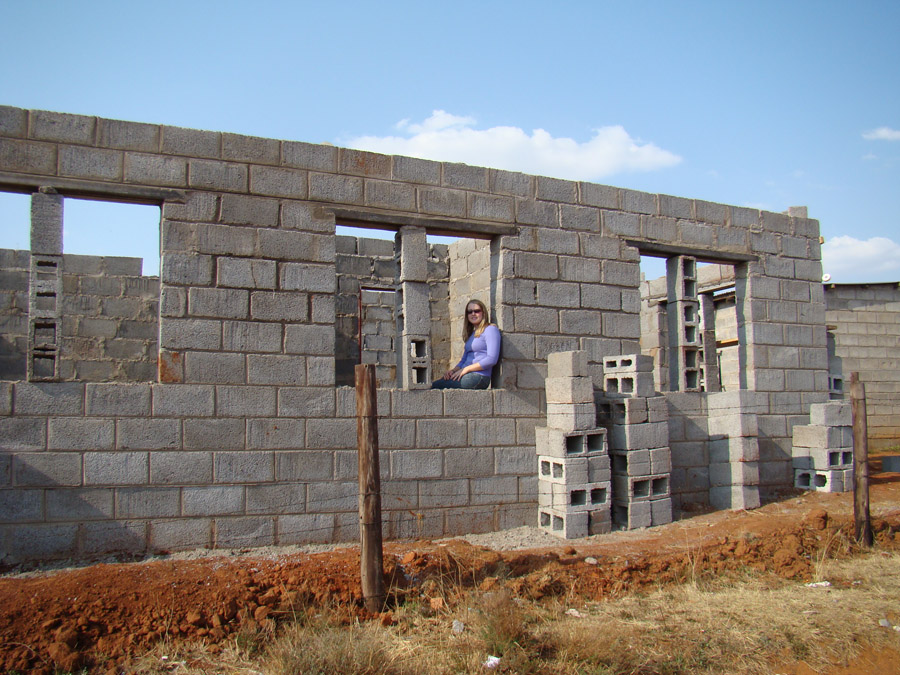 |
|
The house, as we left it |
On the worksite, our local builders were amazed at having seven girls mixing concrete and carrying forty-pound blocks. I don’t think girls really take part in those things normally. One day we were working on leveling soil outside of the house and the soil was extremely compacted. I just got a pickaxe and started to loosen it. That caused a little raucous with the local staff, then after a while, declared with a smile that I could stay. I was also fairly excited when our group leader assigned me to make a step into the latrine. As I thought about formwork and rise over run ratios, our contractor had quite a chuckle and asked if I ever had built anything before. Needless to say, my step became a simple CMU block with concrete ‘spread like butter’ over the top; but it was still my step made be my hand.
Anytime you visit someplace new, you are struck by sites that are completely normal to the locals. Every time we passed a woman with a child on her back we all were amazed. How do get the baby on your back in the first place and then how do you tie one blanket so that the baby doesn’t fall off? And then with the baby on your back, how do you carry a large sack of groceries on your head and stay balanced? Needless to say, we were mighty impressed! It was also strange to not see anyone with cell phones! Each few hundred feet, there would be a wooden stand or a metal shipping container marked “public phone”. At night, when you drove, there were no lights. Where can you go in the US and see that much darkness?
Our time at the build went by very quickly and very slowly at the same time. Our muscles hurt, but we had just started to make noticeable progress with everyone being comfortable talking to us. Before we knew it, we were
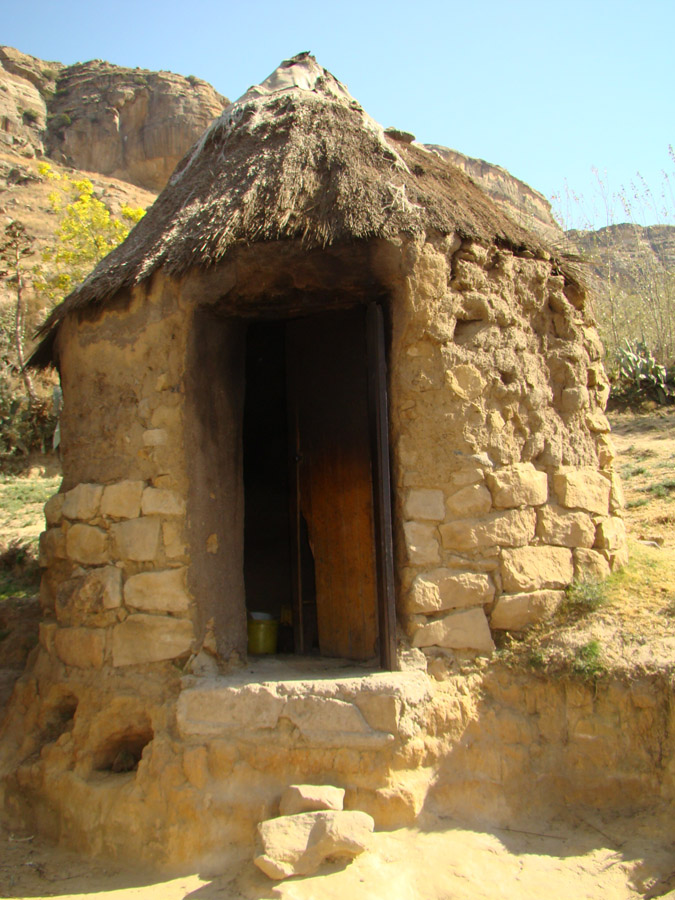 |
|
Traditional rondavel |
done. The house wasn’t, but our time there was.
On our last day in Lesotho, we woke up and I had yet another “first” on the trip. I got to ride a horse, but not just any horse, but the stubborn horse that didn’t want to move let alone carry its heavy rider up Lesotho’s steep inclines. I made it through the horse experience and we headed to our final task.
At the closing dedication, the local Habitat for Humanity affiliate spoke, as well as , the pastor of the host church. We didn’t get to ‘turn over the keys’ because the house wasn’t done; but the community members were still extremely grateful. Each one of us received a wall hanging, handcrafted by ladies from the church with different objects quintessentially from Lesotho. After all the speaking was completed, we passed out jars of bubbles to the kids. I offered a gift that was the best that I could do for bringing something from my home in Pennsylvania to them -- Hershey Kisses. I have to admit we all got a little teary-eyed when we drove away; but I think that is how we knew we did what we came to do.
After flying back to South Africa, four of us spent one final day in Johannesburg. We toured the Apartheid Museum and township of Soweto. I still don’t quite understand townships, but somehow the communities in Soweto were different from Cape Town. Soweto seemed like it was its own place, whereas in Cape Town the townships seemed to be placed wherever they could fit. There were some amazing homes in Soweto, five times as big as my own, but still standing by neighboring shacks. On the street that both Nelson Mandela and Desmond Tutu lived at one time, we had lunch at a popular restaurant. I tried to be adventurous and asked for the house specialty. In hindsight, I should have asked what it was, because when it came out, cow intestines were staring up at me. The waitresses got a good laugh, and I stayed hungry for the long flight home.
I know that words or pictures will never fully capture this experience. This past week during studio class, a studio dedicated to urban design and community development, I did a presentation on the townships of Cape Town. It was then that I truly realized that no matter how many of my photos I showed or stories that I told, they would never quite understand. My travel fellowship allowed me to see yet another away that we live, that we inhabit, and that we succeed in creating residential dwellings.
|
|
|
1.JPG)
Nicole Graycar, Carnegie Mellon University, USA; Habitat for Humanity Global Village Program, Lesotho
|
|











1.JPG)